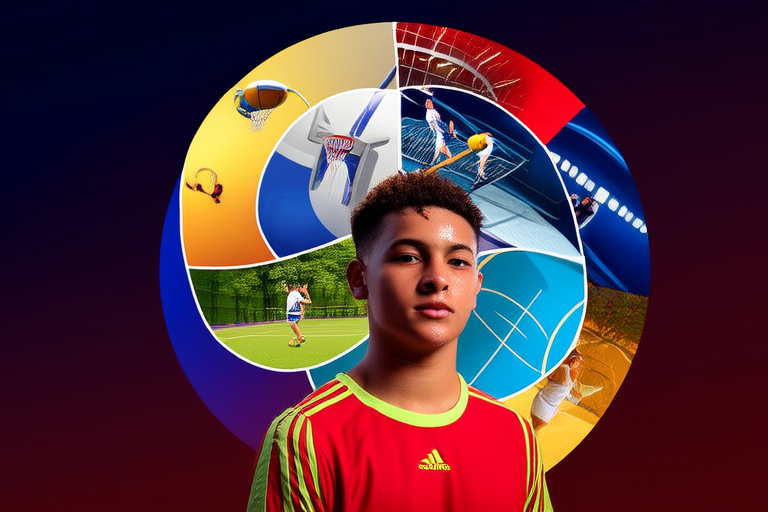Variety of Sports: A Comprehensive Overview
The world of sports is vast and diverse, offering a wide array of activities that cater to different interests, abilities, and preferences. From team sports that emphasize cooperation and strategy to individual sports that focus on personal achievement and discipline, sports play a crucial role in enhancing physical fitness, promoting mental health, fostering social connections, and developing valuable skills. This article delves into the numerous categories of sports available today, highlighting their unique benefits and providing examples to illustrate the rich tapestry of options within the sporting world.
Introduction
Sports have long been recognized for their ability to improve physical health and well-being. However, beyond the physical benefits, participating in sports can also enhance mental health, promote social interaction, and foster personal growth. The variety of sports available today ensures that there is something for everyone, regardless of age, gender, or fitness level. Whether you prefer playing with others or competing against yourself, engaging in sports can be an enjoyable and rewarding experience.
Team Sports
Team sports involve multiple participants working together towards a common goal. These sports often require strategic thinking, communication, and cooperation among teammates. Team sports not only provide opportunities for physical exercise but also promote social interaction and teamwork. Examples of popular team sports include soccer, basketball, volleyball, and rugby. Participating in team sports can help individuals develop leadership skills, improve communication, and learn how to work effectively in a group setting. Additionally, team sports offer a sense of belonging and camaraderie, which can contribute to improved mental health and emotional well-being.
Individual Sports
In contrast to team sports, individual sports focus on personal achievement and self-improvement. These sports allow individuals to compete against themselves and set personal goals. Individual sports can be a great way to build confidence, discipline, and perseverance. Examples of individual sports include tennis, swimming, cycling, and golf. Engaging in individual sports can also provide opportunities for personal reflection and mindfulness, contributing to improved mental health and stress reduction.
Indoor Sports
Indoor sports are ideal for those who enjoy exercising in controlled environments or during inclement weather. These sports often take place in gymnasiums, arenas, or other indoor facilities. Indoor sports can range from low-impact activities like yoga and Pilates to high-intensity workouts like boxing and kickboxing. Examples of popular indoor sports include badminton, table tennis, and rock climbing. Indoor sports can be a great way to stay active year-round and provide a safe environment for those who may be uncomfortable exercising outdoors.
Outdoor Sports
Outdoor sports offer the opportunity to connect with nature and enjoy fresh air while engaging in physical activity. These sports can range from leisurely activities like hiking and picnicking to more intense pursuits like mountain biking and trail running. Outdoor sports can be a great way to reduce stress, improve mood, and increase vitamin D levels. Examples of popular outdoor sports include soccer, cricket, and kayaking. Participating in outdoor sports can also provide opportunities for adventure and exploration, contributing to a greater appreciation for the natural world.
Contact Sports
Contact sports involve physical interaction between players, often resulting in collisions or tackles. These sports can be intense and physically demanding, requiring strength, agility, and endurance. Contact sports can be a great way to build resilience, improve coordination, and develop protective gear. Examples of popular contact sports include American football, rugby, and wrestling. While contact sports can be risky, they can also provide opportunities for personal growth and development, helping individuals build confidence and overcome challenges.
Non-Contact Sports
In contrast to contact sports, non-contact sports do not involve physical interaction between players. These sports can be less intense but still provide opportunities for physical exercise and skill development. Non-contact sports can be a great way to stay active without the risk of injury. Examples of popular non-contact sports include tennis, golf, and swimming. Non-contact sports can also be a great way to reduce stress and improve mental health, contributing to overall well-being.
Competitive Sports
Competitive sports involve formalized competition between individuals or teams. These sports often have strict rules and regulations, and participants may compete at local, national, or international levels. Competitive sports can be a great way to build discipline, improve time management, and develop a strong work ethic. Examples of popular competitive sports include track and field, chess, and synchronized swimming. Participating in competitive sports can also provide opportunities for personal growth and development, helping individuals build confidence and overcome challenges.
Recreational Sports
Recreational sports are informal activities that are primarily focused on enjoyment and fun. These sports may not have formal rules or structured competition, but they still provide opportunities for physical exercise and social interaction. Recreational sports can be a great way to relax, unwind, and enjoy time with friends and family. Examples of popular recreational sports include frisbee, beach volleyball, and parkour. Engaging in recreational sports can also provide opportunities for personal reflection and mindfulness, contributing to improved mental health and stress reduction.
Water Sports
Water sports involve activities that take place in or on the water. These sports can range from leisurely activities like swimming and paddleboarding to more intense pursuits like surfing and windsurfing. Water sports can be a great way to stay cool in hot weather, improve cardiovascular health, and build core strength. Examples of popular water sports include scuba diving, water polo, and rowing. Participating in water sports can also provide opportunities for adventure and exploration, contributing to a greater appreciation for the aquatic world.
Winter Sports
Winter sports involve activities that take place during the colder months of the year. These sports can range from leisurely activities like skiing and snowshoeing to more intense pursuits like ice hockey and bobsledding. Winter sports can be a great way to stay active during the colder months, improve balance and coordination, and build cardiovascular endurance. Examples of popular winter sports include figure skating, curling, and cross-country skiing. Participating in winter sports can also provide opportunities for adventure and exploration, contributing to a greater appreciation for the winter landscape.
Adventure Sports
Adventure sports involve activities that push the boundaries of human capability and challenge participants to explore new frontiers. These sports can range from extreme sports like skydiving and BASE jumping to more moderate pursuits like backpacking and rock climbing. Adventure sports can be a great way to build confidence, improve problem-solving skills, and develop a sense of accomplishment. Examples of popular adventure sports include paragliding, whitewater rafting, and mountain biking. Engaging in adventure sports can also provide opportunities for personal growth and development, helping individuals build resilience and overcome challenges.
Conclusion
The world of sports offers a wealth of opportunities for physical fitness, mental health improvements, social interaction, and skill development. Whether you prefer team sports or individual pursuits, indoor activities or outdoor adventures, contact sports or non-contact games, competitive challenges or recreational fun, water-based excitement or winter wonderlands, or thrilling adventures, there is a sport out there for everyone. By engaging in various forms of sports, individuals can improve their overall well-being, build confidence, and develop valuable skills that will serve them well in all aspects of life. So why not try something new today and discover the joy and benefits of sports?










